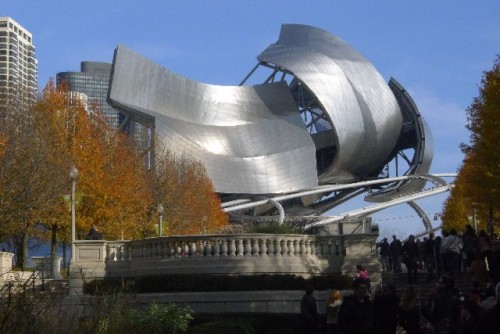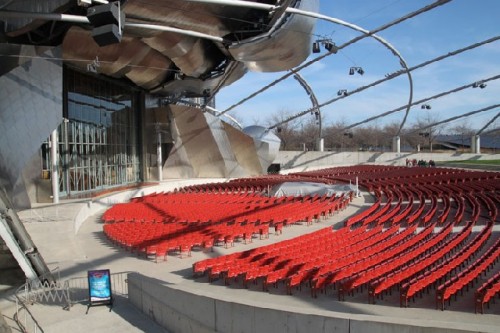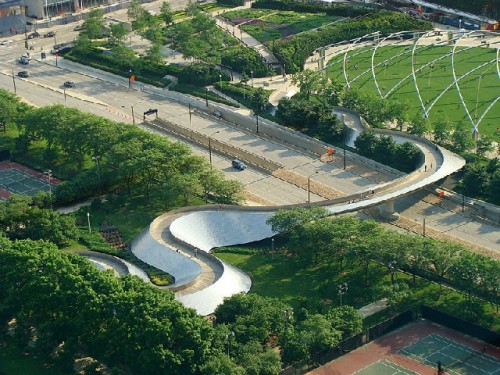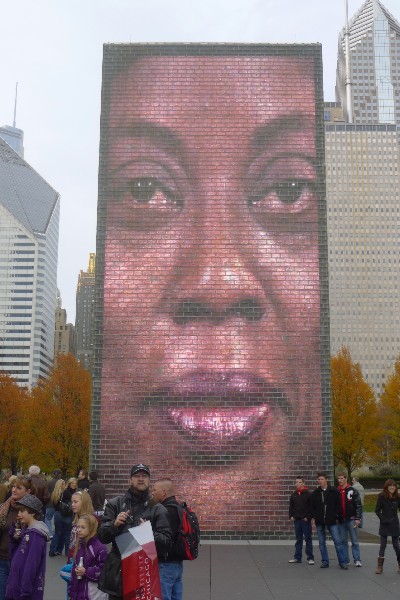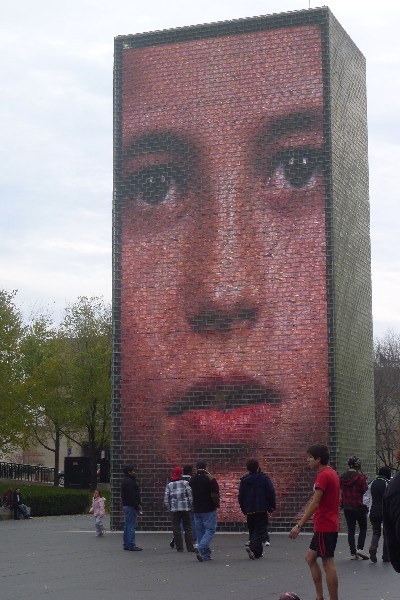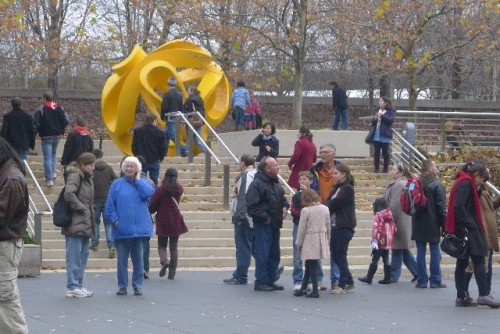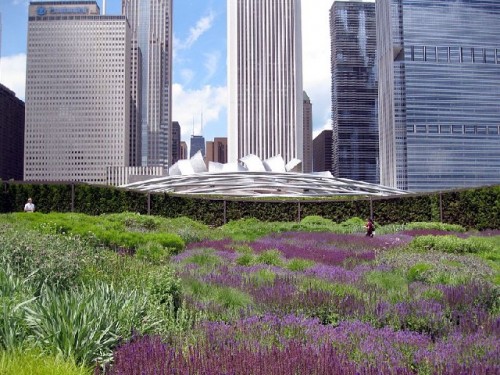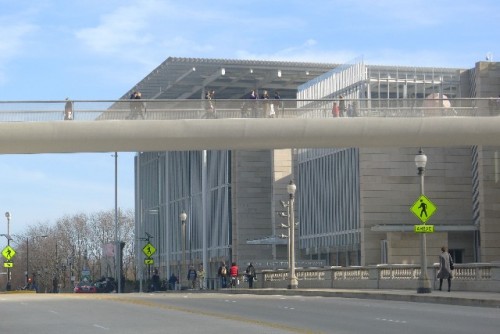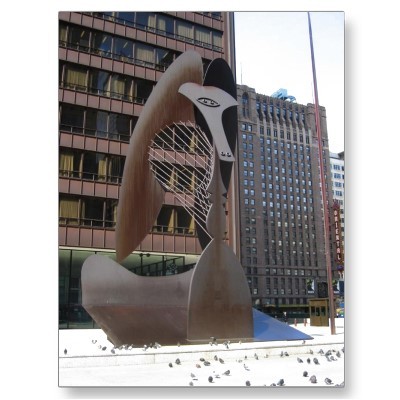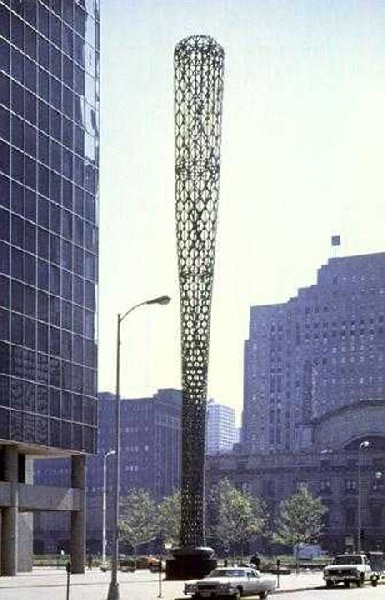Chicago's Magnificent Millennium Park
Iconic Green Space Punctuated By Public Art
By: Mark Favermann - Nov 26, 2011
On a glorious, bright sunny November day, there were literally thousands of visitors to Chicago's imposingly dramatic yet personally appealing urban public space, Millennium Park. Apparently, on any nice day since it opened, the park is full. This downtown oasis says much about 21st Century urban design and even more about the City of Chicago.
When Ted Landsmark, President of the Boston Architectural College, speaks to mayors' groups and other city officials around the US about trends in urban development, he talks about how cities can add prestige and luster to their urban environment. This is not by making an urban or government center the civic focus like was done fifty years ago. Nor does he discuss the creation of major retail or festival marketplaces as were the fad 30 years ago.
Instead Landsmark speaks to the creation of major downtown parks as 21st Century civic focal points. There are certainly others, but the most popular and innovative three examples are Olympic Sculpture Park in Seattle, Highline Park in New York City and Millennium Park in Chicago.
First planned in 1997 as a way to create new parkland in Grant Park and transform unsightly railroad tracks and parking lots, Millennium Park evolved into one of the most significant millennium projects in the world. The other notable one is the Millennium Bridge over the Thames River, officially known as the London Millennium Footbridge.
Millennium Park is a civic center for art, music, architecture and landscape design. It is a result of a unique partnership between the City of Chicago and Chicago's generous philanthropic community. It is a 24.5-acre park that features the work of world-renowned architects, planners, artists, engineers and designers.
Located in downtown Chicago on Michigan Avenue between Randolph and Monroe Streets, the park is a place where you can experience everything from interactive public art and ice skating to al fresco dining and free classical music presentations.
The park has free admission, and besides the Gehry-designed elements, it features Cloud Gate, the Crown Fountain, the Lurie Garden, and various other attractions. The park is connected by the BP Pedestrian Bridge and the Nichols Bridgeway to other parts of Grant Park. Because the park sits atop a parking garage and the commuter rail Millennium Station, it is considered the world's largest rooftop garden.
With all that said, this project is in the City of Chicago, and that means that there was an abundance of criticism including cronyism, cost overruns, poor planning, construction delays, continual design changes and even suggested corruption (apparently very Windy City). The cost overruns were massive, going from a projected $150 million to over $475 million. The burden of which fell on the taxpayers.
Missing the actual Millennium, Millennium Park was opened four years late in 2004. As with all public arts projects, it was harshly criticized for its cost and compared to a similar outlay for the poor of Chicago and/or application to the public school system.
Despite all of this, the resulting Millennium Park is now a point of civic pride for Chicago. It has been critically acclaimed. Also, it is one of the most visited sites in the city. All who enter the park seem to leave with appreciation and a smile.
Breaking down the park into its various elements, each piece of the park is well or brilliantly done. Millennium Park is one of the great public open spaces in the United States and even the world. The major art and architecture creations punctuate the public space both aesthetically and intellectually. This is certainly no mean trick, but a thoughtful application of art, design and engineering.
Notable are the strategic Cloud Gate and Crown Fountain as well as the various architectural elements by Frank Gehry. Each adds to Millennium Park being not just another large scale park but a unique, provocatively designed, beautiful public space.
Among the park's prominent features is the visually spectacular Jay Pritzker Pavilion, considered to be the most sophisticated outdoor concert venue in the United States. It was designed by starchitect Frank Gehry. He also designed the enormous (everything is quite large scale in Chicago) and BP (who paid for it) 960' long Undulating Pedestrian Bridge connecting the Pritzker Pavilion to the rest of Grant Park.
Gehry's BP Bridge, is a quirky snaking piece of practical sculpture. It is sheathed in stainless steel shingles. This pedestrian bridge safely curves across a rather intimidating, rushing Columbus Drive.
Perhaps, the most photographed and beloved element in the park is "Cloud Gate." It is Indian/British artist Anish Kapoor's first public outdoor work installed in the United States. The 110-ton elliptical sculpture is forged of a seamless series of highly polished stainless steel plates, which reflect the city's great skyline and the clouds above.
A 12-foot-high arch provides a "gate" to the concave chamber beneath the sculpture, inviting visitors to touch its mirror-like surface and see their image reflected back from a variety of perspectives. Visitors quickly dubbed the sculpture "The Bean."
Inspired by liquid mercury, the sculpture is among the largest polished stainless steel structures in the world, measuring 66-feet long by 33-feet high. "Cloud Gate" is set upon the At&T Plaza, another corporate gift.
"What I wanted to do in Millennium Park is make something that would engage the Chicago skyline…so that one will see the clouds kind of floating in, with those very tall buildings reflected in the work. And then, since it is in the form of a gate, the participant, the viewer, will be able to enter into this very deep chamber that does, in a way, the same thing to one's reflection as the exterior of the piece is doing to the reflection of the city around," stated artist Anish Kapoor.
Designed by Spanish artist Jaume Plensa, "The Crown Fountain" is said to be inspired by the people of Chicago as well. To the artist, they are an integral part of the art.
The fountain consists of two 50-foot glass block towers at each end of a shallow reflecting pool. The towers project video images from a broad social spectrum of Chicago citizens, a cloever reference to the traditional use of gargoyles in fountains, where faces of mythological beings were sculpted with open mouths to allow water, a symbol of life, to flow out.
Plensa developed a method to have faces of Chicago citizens projected on LED screens and water flow through a water outlet in the screen. It gives the illusion of water spouting from mouths. The collection of faces was taken by Piensa from a cross-section of 1,000 city residents.
The fountain anchors the southwest corner of Millennium Park at Michigan Avenue and Monroe Streets. The water is on from April through October each year with weather permitting. The images remain on year-round. The water was not on when I visited in late November, but the sculpture still was wonderous.
There is a space for temporary public art in Millennium Park as well. The space is a corridor through the park named the Boeing Galleries. It was donated as another corporate gift to the park. This allows sculpture and installations to be placed for limited periods of time as temporary installations.
The current exhibit is of moderately large-scale sculptures by Mexican artist Yvonne Domenge. They are on view from April 6, 2011 through October 2012. Framing the dramatic art and architecture of the Park, Interconnected: The Sculptures of Yvonne Domenge add color and vi0tality to the Millennium Park setting.
Yvonne Domenge’s fascination with organic shapes, form and geometry are evident in her pieces of colorful artwork created specifically for Millennium Park. The South Boeing Gallery has three steel spheres installed.
They include: Tabachin Ribbon, a 13 foot tall yellow sculpture; Wind Waves, a white sculpture measuring approximately 11 feet high and Coral, in blue, approximately 10 feet high. The sculptures are bright, bold and appealing.
The Lurie Garden is a 2.5 acre public garden located at the southern end of Millennium Park. It was designed by Kathryn Gustafson, Piet Oudolf and Robert Israel. The garden is described as a combination of perennials, bulbs, grasses, shrubs and trees. It is the featured nature component of the world's largest green roof.
It was named after philanthropist Ann Lurie, who donated the $10 million endowment. The garden is a tribute to the city, whose motto is "Urbs in Horto", Latin for "City in a Garden". In landscape architectural terms, the Lurie Garden is composed of two "plates." A dark plate depicts Chicago's history presenting shade-loving plants and trees. A light plate, which has no trees, represents the city's future with sun-loving perennials that thrive in heat and light.
Designed by Italy's starchitect Renzo Piano, the same architect responsible for the Art Institute of Chicago's elegant new Modern Wing, the sloping 620' Nichols Bridgeway spans Millennium Park to the Art Institute. It is literally a sidewalk above the treetops. This straight pathway contrasts markedly to Gehry's undulating bridge. The Nichols Bridgeway gives the visitor an aerial view of Millennium Park.
The City of Chicago historically has had major public art pieces set throughout its downtown area for over 40 years. Beginning with Untitled by Pablo Picasso in 1967 and followed by Alexander Calder's Flamingo (1973) and Claus Oldenburg's Bat Column (1977), major precedent-setting public sculptures have been integral parts of the urban fabric for decades. So it was not a big stretch for major pieces of public art to be commissioned for Millenium Park.
In 1893, Chicago celebrated the World's Columbian Exposition. The official name for this major event was either the Columbian Exposition or The Chicago World's Fair. It signified the 400th anniversary of Christopher Columbus' arrival at the New World in 1492. The fair had a profound effect on architecture, the arts, Chicago's self-image, and American industrial optimism. In a major way, it set the tone for the 20th Century.
Millennium Park is a Chicago statement. It is bold and democratic, a brilliant public park and a glorious pedestal for major public art. It is a wonderful space. Set at roughly the same location, Millennium Park echoes and underscore the vibrancy and hope of the 1893 Chicago World's Fair. Millennium Park sets a gold standard for parks in the 21st Century.

